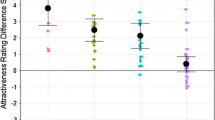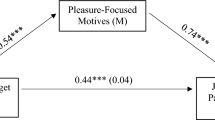Abstract
In Samoa, feminine natal males who possess male-typical genitalia are known locally as fa’afafine. Some Samoan men express sexual interest in fa’afafine, whereas others do not. To assess the sexual orientation of men who are sexually interested in fa’afafine, we collected sexual attraction ratings and viewing times of Samoan men’s and women’s faces. Study 1 (N = 130) focused on men who were insertive or versatile during anal sex with fa’afafine partners. These men were compared to each other, as well as to males (i.e., men and fa’afafine) who were exclusively sexually interested in either women or men. Study 2 (N = 180) compared men who had sex with fa’afafine and women; men who had sex with fa’afafine, women, and men; and men who had sex with fa’afafine and men. These men were compared to each other, as well as to males who were exclusively sexually interested in either women or men. These studies suggest that men who have sex with fa’afafine are a heterogeneous group. A small portion of the men who are sexually interested in fa’afafine shows a relatively bisexual pattern of sexual attraction ratings and viewing times, namely men who have sex with fa’afafine, men, and women. In contrast, a larger number of men who were sexually interested in fa’afafine responded in a manner similar to men who were exclusively sexually interested in either women or men. The present research suggests that additional insights into male sexual orientation can be garnered by focusing on how sexuality is expressed in non-Western cultural contexts.


Similar content being viewed by others
Notes
If participants respond to men and women in a similar manner, this could indicate that they are highly attracted to both genders, but it could also indicate that they are minimally attracted to both genders. The latter is inconsistent with ambiphilia. However, if they respond to men and women in a relatively similar manner and also report greater attraction to their lesser-preferred gender and view their lesser-preferred gender longer than monosexual individuals, the second possibility can be ruled out.
Petterson et al. (2015) compared men who had sex with fa’afafine, as a group, to fa’afafine and men who have sex with only women. Petterson et al. (2016) compared men who had performed and received oral sex with fa’afafine partners and those who had only received oral sex from fa’afafine; these men were further compared to fa’afafine and men who had sex with only women. Additional participants were recruited following the aforementioned studies. Petterson et al. (2018) compared cisgender androphilic men and fa’afafine.
Although the Hedge’s g for the comparison of the magnitude of the difference in viewing times was moderate, the confidence intervals were wide and the lower bracket was near 0.
References
Bailey, J. M. (2009). What is sexual orientation and do women have one? In D. A. Hope (Ed.), Contemporary perspectives on lesbian, gay, and bisexual identities (pp. 43–64). New York: Springer.
Bailey, J. M., Vasey, P. L., Diamond, L. M., Breedlove, S. M., Vilain, E., & Epprecht, M. (2015). Sexual orientation, controversy, and science. Psychological Science in the Public Interest,17, 45–101.
Benson, P. J., & Perrett, D. I. (1993). Extracting prototypical facial images from exemplars. Perception,22, 257–262. https://doi.org/10.1068/p220257.
Bianchi, F. T., Reisen, C. A., Zea, M. C., Vidal-Ortiz, S., Gonzales, F. A., Betancourt, F., … Poppen, P. J. (2014). Sex work among men who have sex with men and transgender women in Bogotá. Archives of Sexual Behavior,43, 1637–1650. https://doi.org/10.1007/s10508-014-0260-z.
Bockting, W., Miner, M., & Rosser, B. R. S. (2007). Latino men’s sexual behavior with transgender persons. Archives of Sexual Behavior,36, 778–786. https://doi.org/10.1007/s10508-006-9133-4.
Boellstorff, T. (2004). Playing back the nation: Waria, Indonesian transvestites. Cultural Anthropology,19, 159–195. https://doi.org/10.1525/can.2004.19.2.159.
Carballo-Diéguez, A., & Dolezal, C. (1994). Contrasting types of Puerto Rican men who have sex with men. Journal of Psychology and Human Sexuality,6, 41–67.
Cardoso, F. L. (2005). Cultural universals and differences in male homosexuality: The case of a Brazilian fishing village. Archives of Sexual Behavior,34, 103–109. https://doi.org/10.1007/s10508-005-1004-x.
Coan, D. L., Schrager, W., & Packer, T. (2005). The role of male sexual partners in HIV infection among male-to-female transgendered individuals. International Journal of Transgenderism,8, 21–30. https://doi.org/10.1300/J485v08n02_03.
Devereux, G. (1937). Institutionalized homosexuality of the Mohave Indians. Human Biology,9, 498–527.
Dixson, B. J., Little, A. C., Dixson, H. G., & Brooks, R. C. (2017). Do prevailing environmental factors influence human preferences for facial morphology? Behavioral Ecology,28, 1217–1227. https://doi.org/10.1093/beheco/arx067.
Donham, D. L. (1998). Freeing South Africa: The “modernization” of male–male sexuality in Soweto. Cultural Anthropology,13, 3–21.
Eternity and Empirisoft Corporation. (1997). MediaLab research software. New York: Empirisoft Corporation.
Greenberg, D. F. (1988). The construction of homosexuality. Chicago: University of Chicago Press.
Hall, G. C., Young, A., Krakauer, C., Watson, C. C., Cummings, V., Mayer, K., & Koblin, B. (2017). Sexual risk behaviors among black men who have sex with men who also report having sex with transgender partners: Analysis of HIV Prevention Trials Network (HPTN) 061 Study. AIDS Education and Prevention,29, 418–431. https://doi.org/10.1521/aeap.2017.29.5.418.
Haller, D. (1992). Homosexuality in Seville. Solgan,14, 27–35. https://doi.org/10.1525/sol.1992.14.3.27.
Howe, C., Zaraysky, S., & Lorentzen, L. (2008). Transgender sex worker and sexual transmigration between Guadalajara and San Francisco. Latin American Perspectives,35, 31–50. https://doi.org/10.1177/0094582X07310956.
Imhoff, R., Schmidt, A. F., Nordsiek, U., Luzar, C., Young, A. W., & Banse, R. (2010). Viewing time effects revisited: Prolonged response latencies for sexually attractive targets under restricted task conditions. Archives of Sexual Behavior,39, 1275–1288. https://doi.org/10.1007/s10508-009-9595-2.
Imhoff, R., Schmidt, A. F., Weiß, S., Young, A. W., & Banse, R. (2012). Vicarious viewing time: Prolonged response latencies for sexually attractive targets as a function of task- or stimulus-specific processing. Archives of Sexual Behavior,41, 1389–1401. https://doi.org/10.1007/s10508-011-9879-1.
Johnson, M. (1998). Global desiring and translocal loves: Transgender and same-sex sexualities in the southern Philippines. American Ethnologist,24, 695–711. https://doi.org/10.1525/ae.1998.25.4.695.
Kulick, D. (1997). The gender of Brazilian transgendered prostitutes. American Anthropologist,99, 574–585. https://doi.org/10.1525/aa.1997.99.3.574.
Lancaster, R. N. (1988). Subject honor and object shame: The construction of male homosexuality and stigma in Nicaragua. Ethnology,27, 11–125.
Lim, D. C. L. (2015). Visualizing the invisible: Social constructions of straight identified men who have sex with transsexual and feminized gay men on/off Malaysian film. Studies in Gender and Sexuality,16, 183–203. https://doi.org/10.1080/15240657.2015.1073047.
Little, A. C., & Hancock, P. J. B. (2002). The role of masculinity and distinctiveness in judgments of human male facial attractiveness. British Journal of Psychology,93, 451–464. https://doi.org/10.1348/000712602761381340.
Mauk, D., Perry, A., & Muñoz-Laboy, M. (2013). Exploring the desires and sexual culture of men who have sex with male-to-female transgender women. Archives of Sexual Behavior,42, 793–803. https://doi.org/10.1007/s10508-013-0079-z.
Oetomo, D., & Edmond, B. (1993). Homosexuality in Indonesia. Paper presented at the International Conference on AIDS, Berlin.
Operario, D., Burton, J., Underhill, K., & Sevelius, J. (2008). Men who have sex with transgender women: Challenges to category-based HIV prevention. AIDS and Behavior,12, 18–26. https://doi.org/10.1007/s10461-007-9303-y.
Petterson, L. J., Dixson, B. J., Little, A. C., & Vasey, P. (2015). Viewing time measures of sexual orientation in Samoan cisgender men who engage in sexual interactions with fa’afafine. PLoS ONE,10, e0116529. https://doi.org/10.1371/journal.pone.0116529.
Petterson, L. J., Dixson, B. J., Little, A. C., & Vasey, P. (2016). Reconsidering male bisexuality: Sexual activity role and sexual attraction in Samoan men who engage in sexual interactions with fa’afafine. Psychology of Sexual Orientation and Gender Diversity,3, 11–26. https://doi.org/10.1037/sgd0000160.
Petterson, L. J., Dixson, B. J., Little, A. C., & Vasey, P. (2018). Viewing time and self-report measures of sexual attraction in Samoan cisgender and transgender androphilic males. Archives of Sexual Behavior,47, 2427–2434.
Prieur, A. (1994). ‘I am my own special creation’: Mexican homosexual transvestites’ construction of femininity. Young,2, 3–17.
Reback, C. J., Kaplan, R. L., Bettcher, T. M., & Larkins, S. (2016). The role of the illusion in the construction of erotic desire: Narratives from heterosexual men who have occasional sex with transgender women. Culture, Health, & Sexuality,18, 951–963. https://doi.org/10.1080/13691058.2016.1150515.
Rieger, G., & Savin-Williams, R. C. (2012). The eyes have it: Sex and sexual orientation differences in pupil dilation patterns. PLoS ONE,7, e40256. https://doi.org/10.1371/journal.pone.0040256.
Rosenthal, A. M., Hsu, K. J., & Bailey, J. M. (2017). Who are gynandromorphophilic men? An internet survey of men with sexual interest in transgender women. Archives of Sexual Behavior,46, 255–264. https://doi.org/10.1007/s10508-016-0872-6.
Rosenthal, A. M., Sylva, D., Safron, A., & Bailey, J. M. (2011). Sexual arousal patterns of bisexual men revisited. Biological Psychology,88, 112–115. https://doi.org/10.1016/j.biopsycho.2011.06.015.
Rosenthal, A. M., Sylva, D., Safron, A., & Bailey, J. M. (2012). The male bisexuality debate revisited: Some bisexual men have bisexual arousal patterns. Archives of Sexual Behavior,41, 135–147. https://doi.org/10.1007/s10508-011-9881-7.
RStudio Team. (2015). RStudio: Integrated development for R. Boston: RStudio Inc.
Savin-Williams, R. C., & Vrangalova, Z. (2013). Mostly heterosexual as a distinct sexual orientation group: A systematic review of the empirical evidence. Developmental Review,33, 58–88. https://doi.org/10.1016/j.dr.2013.01.001.
Semon, T. L., Hsu, K. J., Rosenthal, A. M., & Bailey, J. M. (2017). Bisexual phenomena among gay-identified men. Archives of Sexual Behavior,46, 237–245. https://doi.org/10.1007/s10508-016-0849-5.
Stief, M. (2017). The sexual orientation and gender presentation of hijra, kothi, and panthi in Mumbai, India. Archives of Sexual Behavior,46, 73–85. https://doi.org/10.1007/s10508-016-0886-0.
Sweet, M. J., & Zwilling, L. (1993). The first medicalization: The taxonomy and etiology of queerness in classical Indian medicine. Journal of the History of Sexuality,3, 590–607.
Tiddeman, B., Burt, M., & Perrett, D. (2001). Prototyping and transforming facial textures for perception research. IEEE Computer Graphics and Applications,21, 42–50. https://doi.org/10.1109/38.946630.
Tucker, C., Galindo Arandi, C., Bolaños, J. H., Paz-Bailey, G., & Barrington, C. (2014). Understanding social and sexual networks of sexual minority men and transgender women in Guatemala City to improve HIV prevention efforts. Journal of Health Care for the Poor and Underserved,25, 1698–1717. https://doi.org/10.1353/hpu.2014.0163.
Vrangalova, Z., & Savin-Williams, R. C. (2012). Mostly heterosexual and mostly gay/lesbian: Evidence for new sexual orientation identities. Archives of Sexual Behavior,41, 85–101. https://doi.org/10.1007/s10508-012-9921-y.
Weinberg, M. S., & Williams, C. J. (2010). Men sexually interested in transwomen (MSTW): Gendered embodiment and the construction of sexual desire. Journal of Sex Research,47, 374–383. https://doi.org/10.1080/00224490903050568.
Whitam, F. L. (1992). Bayot and callboy in the Philippines. In S. O. Murray (Ed.), Oceanic homosexualities (pp. 231–248). New York: Garland.
Whitam, F. L. (1995). Os entendidos: Gay life in São Paulo in the 1970s. In S. O. Murray (Ed.), Latin American male homosexualities (pp. 39–49). Albuquerque: University of Mexico Press.
Wikan, U. (1977). Man becomes woman: Transexualism in Oman as a key to gender roles. Royal Anthropological Institute of Great Britain and Ireland,12, 304–319.
Wright, T. (2000). Gay organizations, NGOs, and the globalization of sexual identity: The case of Bolivia. Journal of Latin American Anthropology,5, 89–111. https://doi.org/10.1525/jlca.2000.5.2.89.
Acknowledgements
We thank Leituala Kuiniselani Toelupe Tago-Elisara, Louisa Apelu, Laulu Seuamuli Henry Taefu, Paul Ah Kuoi, Trisha Tuiloma, Alatina Ioelu, John Sylla, Samoan Ministry of Women, Community and Social Development, Samoan Immigration, the Tapuai Kuka II family of Savai’i, and all of the individuals who agreed to participate in our study. Various stages of this research were supported by the University of Lethbridge, Victoria University of Wellington and the University of Stirling; by a SSHRC Masters and Doctoral Scholarship to LJP; by a New Zealand International Doctoral Scholarship to BJD; by a Royal Society University Research Fellowship to ACL; and, by a Natural Sciences & Engineering Research Council of Canada Discovery Grant and an American Institute of Bisexuality Grant to PLV.
Author information
Authors and Affiliations
Corresponding author
Ethics declarations
Conflict of interest
The authors declare that they have no conflict of interest.
Ethics Approval
This research was approved by an institutional human participants research ethics board. A Samoan Research Visa was obtained from Samoan Immigration.
Informed Consent
Participants were required to provide informed written consent prior to taking part in the study.
Additional information
Publisher's Note
Springer Nature remains neutral with regard to jurisdictional claims in published maps and institutional affiliations.
Rights and permissions
About this article
Cite this article
Petterson, L.J., Dixson, B.J., Little, A.C. et al. Heterogeneity in the Sexual Orientations of Men Who Have Sex with Fa’afafine in Samoa. Arch Sex Behav 49, 517–529 (2020). https://doi.org/10.1007/s10508-020-01646-6
Received:
Revised:
Accepted:
Published:
Issue Date:
DOI: https://doi.org/10.1007/s10508-020-01646-6




